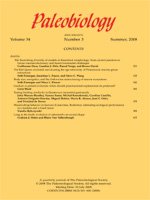The purpose of this paper is to explore the possibility and utility of estimating multivariate selection in fossil assemblages, using naticid gastropods as a case study. We used the presence or the absence of a naticid borehole as an index of survival with respect to drilling attacks, enabling us to estimate the multivariate selection gradient exerted by this predator on the shell length and shell thickness of two bivalve genera, Astarte and Spisula. We hypothesized that naticid selection pressure would favor the survival of large, thick-shelled bivalve prey throughout the Cenozoic.
Differential survival of prey was recorded over geologic time using processed bulk assemblages from the Miocene, Pliocene, and Pleistocene Epochs. Multivariate logistic regressions were performed by time period to determine if length and thickness were important factors affecting survival. The direction and magnitude of selection on length and thickness for the two genera ranged from zero (no selection) to large positive or negative values. Only two selection coefficients were significant after sequential Bonferroni corrections: thin-shelled Astarte survived substantially better than thick-shelled Astarte during the Pleistocene (βavggrad = −1.23) and large Spisula survived slightly better than small Spisula during the Miocene Epoch (βavggrad = 0.05).
This is the first study using fossils to calculate multivariate selection gradients. It suggests that naticids were not necessarily strong agents of selection on two traits previously thought to be important to survival of drilling attacks for two of their common prey species. We also show that multivariate selection gradient estimates differ from traditional predation intensity estimates but are superior for estimating the magnitude and direction of natural selection because they use differential mortality of different prey phenotypes rather than just absolute mortality from predation. This work is especially significant for research that involves estimating the relative importance of predation (naticid or otherwise) as an evolutionary force and will be useful for fossil studies where differential survival can be recorded.





